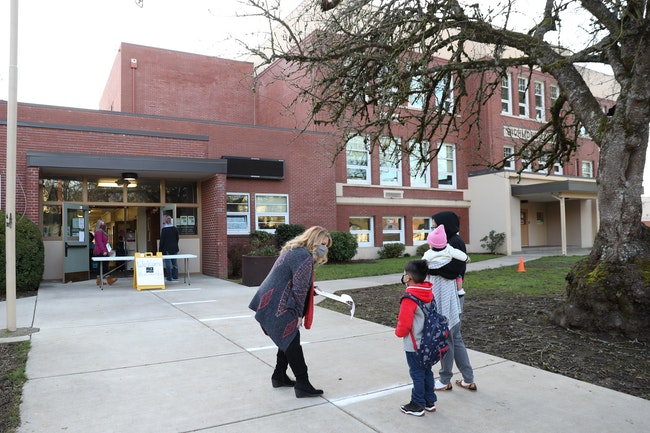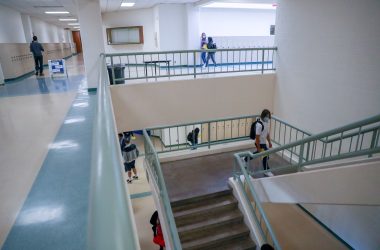
Maggie Rivera, community school outreach coordinator, greets students for the first day back to school at Richmond Elementary on Tuesday, March 2. (Amanda Loman/Salem Reporter)
State school and education leaders said Tuesday that despite new data showing that decades of school funding gaps in the state have been nearly closed, many districts are still underfunded.
They were reacting to a new report that found the 2021 legislative budget for schools “represents a significant narrowing of the insufficiency reported in past years.”
The report was shared with policy makers and school leaders just last week, and was the latest assessment of how well Oregon is doing funding its schools.
It comes from the state Quality Education Commission and the Legislative Policy and Research Office. The commission’s role is to determine the amount of funding needed for Oregon schools to meet broad education goals.
“Report on Adequacy of Public Education Funding” focused on one key measure of school performance – graduation rates. The commission suggested that the state could increase the graduation rate with even more funding, from a 2020 high of 83% of Oregon high school seniors graduating to 90% by 2025.
The idea of more funding was strongly endorsed by school leaders during a meeting Tuesday of the Joint Interim Special Committee on Public Education Appropriation. The committee includes Senators Lew Frederick (D-Portland) and Michael Dembrow (D-Portland), and House Representatives Susan McLain (D-Hillsboro), Teresa Alonso León (D-Woodburn), and Suzanne Weber (R-Tillamook).
The legislators were joined by lobbyists and representatives from professional teachers, school employee and school administrators associations, as well as representatives from the Hillsboro school district and board.
Despite the historic increase in funding for schools in the last legislative session, those testifying Tuesday warned that the report painted too rosy a picture. Per-pupil spending in Oregon was about 6% below the national average during the 2018-19 school year, according to the U.S. Census Bureau.
Bob Estabrook, a lobbyist for the Oregon School Employees Association, a union for education employees, said there’s “a very real concern that this report casts the situation in Oregon schools as being fine, or that at the very least help is on the way, that we are making progress. And I need to be really clear on behalf of my members, that that does not match their perception. That is not what they are seeing and feeling in schools today.”
The report concluded that the most recent legislative budget was more closely inline with projected school needs than ever.
Between 1999 and 2001, for example, state officials estimated the Legislature’s budget was 24% short of covering expected schools costs. In the current state budget, the gap is expected to close to 6%.
That still would leave Oregon’s school system short $577 million from their projected needs of $9.86 billion. The 2021 Legislature allotted $9.3 billion.
Several witnesses questioned why legislators left even that gap.
Mark Watson, chair of the Hillsboro School Board, said that his district had been forced to use money from the Student Success Act, allocated specifically for increasing curriculum offerings, before and after school programs, student mental health and safety among other things, on general operating expenses.
“With economic forecasting and continued growth post-pandemic, I ask that we also find a way to grow our investments,” he said.
Estabrook said years of underinvestment coupled with Covid-19 impacts are exacerbating long standing issues at Oregon schools.
Witnesses said school staff are dealing with higher rates of behavioral issues and learning disabilities among students, recruitment and retention of teachers and other staff, and inadequate funding for school maintenance and repair.
In an interview after the meeting, Dembrow said the school funding problem traces to 1990, when voters capped the percentage of local property taxes that would be dedicated to school funding. This put the burden on the Legislature to make up the funding for districts.
“And we didn’t get any more funding to help them,” he said.
Dembrow criticized the new report for relying only on graduation rates as the key metric of quality education.
“Graduation rates don’t really tell the whole story of the whole student and what they need,” he said.
Additionally, he said that on top of growing student needs from the pandemic, one reason schools are asking for more money is that, “Frankly, our ambitions are higher.”
He said schools now have to do more for college and career preparation, and more seriously address the highest needs students and student mental health.
He said he wants to see more details in future reports about what happens to students after they leave high school.
Oregon Capital Chronicle is part of States Newsroom, a network of news bureaus supported by grants and a coalition of donors as a 501c(3) public charity. Oregon Capital Chronicle maintains editorial independence. Contact Editor Les Zaitz for questions: [email protected]. Follow Oregon Capital Chronicle on Facebook and Twitter.
STORY TIP OR IDEA? Send an email to Salem Reporter’s news team: [email protected].









